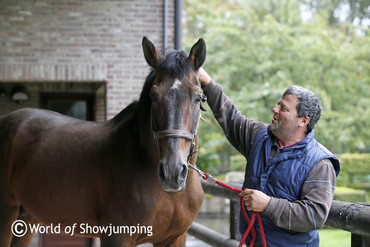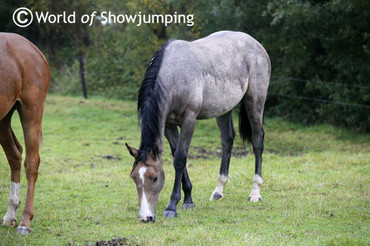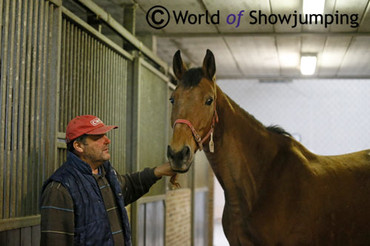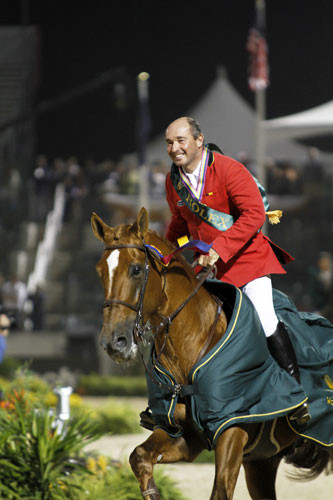
Joris de Brabander together with the star - Nabab de Reve. All photos (c) Jenny Abrahamsson.
He has bred super stars like London, Exquis Walnut de Muze, Derly Chin de Muze and Estoi Aqui de Muze – so there was no question, we had to visit Joris de Brabander. WoSJ decided to travel to Belgium to meet the man behind the very successful Stal de Muze. Joris is also the owner of the famous stallion Nabab de Reve who has sired numerous top showjumpers, bought by Joris when he was two days old - and the reigning World Champion Vigo D'Arsouilles, that was bought by Joris as a two month old colt.
Joris is a ground breaking living legend, and we quickly discover that it is very inspiring to talk to a man with such big knowledge. De Brabander is a veterinarian, and was one of the first to use embryo transfer when he started with it in 1994. Today more than 250 embryo transfers are made at Stal de Muze every year, and Joris is always at the search of the very best mares for this purpose.

A one year old out of the clone of Ratina Z at Stal de Muze.
"My dream mare has always been Ratina Z. Now I have a one year old by the clone of Ratina Z, and that is amazing!" Joris says very happy.
At the fields around the stud we find one celebrity after the other - Hickstead's mum is here, as is Malin Baryard-Johnsson's success horse Butterfly Flip ( they were ranked as the world's best showjumping pair in 2003), a granddaughter of Fine Cera, Helena Lundbäck's Mynta who was fourth at the WEG in 2002, Michal Whitaker's Portofino and the list goes on and on. We also find several foals out of clones, and this year several foals out of the Gem Twist clone was born at Stal de Muze. Next year Joris is expecting two foals out of the clone of ET. "I do believe in science and I do believe in genetics – and you have to try to know."
Joris breed about twenty foals himself every year, and start his selection early. "The goal is to keep only two fillies and two colts, and of course I want to keep the best ones."

Michael Whitaker's former star Portofino.
But is it only the breeding that has made the success for Stall de Muze we ask: "The breeding is very important. If the horses doesn't have the genetic print it is impossible to get a good horse. But it is also very important how they grow up. During the first five or six years you are not allowed to do any mistakes," Joris explains.
"For me the breeding and the sports career start already in the belly of the mother. It is important that the mares are able to move a lot, get good and normal food and that they are big enough. After they are born many foals and youngsters stay inside from October or November to the year after when they can go out on the fields again, and that is bad for them. They are not moving enough and in my opinion they need to be able to move and run over big areas as much as possible - also in the winter."
And it is not only the youngsters that spend as much time as possible in the fields at Stal de Muze. "Every hour and every day that the horses spend in their boxes are bad moments. In many stables it is like in prison, where the prisoners just get out one hour a day and spends the rest of the 23 hours in the cell. Of course that is bad for the success of the horses. For me the box is the biggest enemy for the horses, the food is the second worst enemy – they often get too much food and are growing to fast. To feed normal is important. The third worst enemy is the human factor. You can't even believe how many mistakes we can make. A horse needs a life of a horse and not a life of a human."

"Every hour and every day that the horses spend in their boxes are bad moments," Joris says.
Joris knows the horses at the stud inside out, and points out the importance of knowing both the mother and the father of the offspring. "It is not about just knowing the names of the parents; it is about knowing how they are to ride, to transport and to handle. If you know that the mare was a late bloomer or that the stallion behaved a certain way as a youngster you can have more patient and understanding for the offspring. So it is important to know the parents when you judge a young horse."
Joris starts to select his horses very early and let them free-jump with their mothers already at the age of three - five months. "It is important to see them jump, but it is also important as an education for the foals," Joris explains.
"But the most important factors a horse needs for success is the ones you can't see. Their mentality, their character and behavior – that they are careful, and not just with the fences but with everything they meet in life. Those things are more important than an x-ray. A successful horse has all of this."
"I do change my point of view about the offspring every day, so for me it is important to see them grow up. Sometimes I sell some foals that I don't think will be good enough and then it is amazing to be proven wrong."

Vigo D'Arsouilles with Philippe Le Jeune at the World Equestrian Games in Kentucky 2010.
Gerco Schröder's ride London - born as Carembar de Muze - was bred and educated at Stal de Muze. "He was a star from the beginning. I did a huge mistake selling half of him to a friend of mine and after he performed really well as a youngster he was sold to Eurocommerce as a five year old. Normally he was a horse I wouldn't have sold, but we got good money for him – even though we probably sold him way too cheap when you look at his career today," Joris laughs.
"Estoi Aqui de Muze that has been competing with Kevin Staut was sold as a four year old. Normally I always breed with my youngsters, but she was a normal type and had a strange character. She jumped really good, but was a real mare. Derly Chin de Muze, who competed with Eric Lamaze for a while, was sold as a three year old and was extremely careful as a youngster."
Vigo D'Arsouilles was bought as a two month old when his mother came to Stal de Muze to get inseminated again. "I liked him as soon as I saw him. He was shown for customers as a youngster, but I always asked for a lot of money for him so luckily he was never sold. He jumped normal as a foal, but later on he could jump 30 cm higher than the rest. He was unbelievable scopey and moved really well. Vigo is still at Philipp Le Jeune's yard, and he still gets ridden and jumped every week - that keeps him happy!"
Photos and text by Jenny Abrahamsson - copyright © worldofshowjumping.com 2013.








